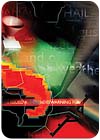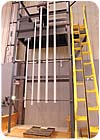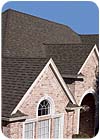Hail and Hearty
The roofing systems installed today are the result of significant suffering and learning, reflecting the lessons learned from fires, wind, heat and chemical reactions. Hail has always been a significant, if infrequent, threat to roofing systems, which bear the brunt of the force when the hailstones fly. For the last 10 years, the roofing industry has grappled with this problem after getting earfuls from the insurance industry. Tired of replacing roofs multiple times in "hail alleys" of the United States, companies have been offering discounts on homeowners insurance for dwellings with approved hail-resistant roofing materials.

The roofing systems installed today are the result of significant suffering and learning, reflecting the lessons learned from fires, wind, heat and chemical reactions. Hail has always been a significant, if infrequent, threat to roofing systems, which bear the brunt of the force when the hailstones fly. For the last 10 years, the roofing industry has grappled with this problem after getting earfuls from the insurance industry. Tired of replacing roofs multiple times in "hail alleys" of the United States, companies have been offering discounts on homeowners insurance for dwellings with approved hail-resistant roofing materials. State Farm, which offers such discounts in 21 states, is on the leading edge of mitigating household damage that saves money and hassles for both the company and consumer.
"If we can help set techniques and help establish practices, that would make a home safer or require fewer repairs," says Jeff McCollum, media specialist for State Farm. "Obviously, it's going to drive down the cost of the premium for the consumer."

"We are the world's largest buyer of shingles," says McCollum. "We're always looking around and always testing."
The company began impact testing roofing materials on its own in 1996, when the industry standard for impact resistance, UL 2218, was introduced. Using steel balls of different sizes dropped from various heights, the test rates roofing systems on a scale of 1 to 4, with 4 being the most resistant. Back then, the company found that less than half of the 100 materials it tested were undamaged after the test. State Farm began a campaign to educate contractors, manufacturers and consumers about the importance of impact-resistant roofing; it currently lists over 400 roofing products that qualify for some level of discount.
Starting in 1996, the company offered discounts in a few states, and it grew from there. Data showed that while areas like Texas and Oklahoma have more frequent storms, Colorado and Kansas can be the site of more severe storms that wreak havoc on roofs, plants, cars and anything else exposed to the elements. With an estimated 3,000 hailstorms in the United States per year, the insurance industry covering these losses wants to get its money's worth.
Hail-resistant shingles are slightly more expensive, and roofing manufacturers do not warrantee them against hail damage. Some don't even promote their Class 4 test results because of liability concerns. Whether this extra measure of durability can get homeowners through an event without sustaining additional damage or maybe avoid damage altogether, no one can say for sure. But insurance companies are willing to offer discounts and promote the gospel of hail resistance.

McCollum says that State Farm's Vehicle Research Facility does work with body shops to improve techniques for popping out small dents and with manufacturers to formulate paints that can withstand sudden impacts and minor repairs.
A lot is asked of roofing as well, and the amount of testing performed on products and systems covers just about anything that can affect a roof. One concern about the UL 2218 is that it, like other tests, doesn't account for the natural aging a roof undergoes. Systems might react differently to years of exposure to heat, moisture, debris, wind, and foot traffic, leading to concerns that products might lose their hail resistance over time.
Certainly no one expects a roof to be left in place after a fire, but hail is a different story. Membrane damage may not always be immediate and cosmetic damage doesn't necessarily affect performance. There have been reports of lawsuits filed against insurance companies when building owners don't realize until years after a hailstorm that they have a claim. If they switch companies in the meantime, roofing contractors can be caught in the middle of a nasty fight about who's going to pay.
In February, a hailstorm in St. Louis damaged hundreds of cars, but the damage to roofing appears to be minimal. A spot check with a few roofing contractors in the area indicates that little if any business will come from the event. Brad Yager, president of Yager Enterprises in St. Louis, sent out 1,700 fliers to the area affected but got only two phone calls. One was for a polyurethane foam roof that was about three years old, Yager's specialty. He says that hailstorms are so infrequent that his system can withstand them.
"That's a good thing about foam, that it can sustain hail damage and not leak," says Yager, who experienced a hailstorm soon after starting his company, but said that such storms were infrequent. "It's not a recurring thing."
It seems that the very nature of hail makes it difficult to replicate in a test. For instance, what happens when a roof is cooking in the sun at 150 degrees F, then there's a wash of cold water and then pounding hail? It's a scenario that Greg Malarkey has considered. The senior vice president of Malarkey Roofing Products in Portland, Ore, has a lot of experience with the effects of inclement weather, and he knows that the dynamic depicted above can happen.
"The test needs to replicate that kind of situation," he says. "We'll support substantial modification to the test. We also support heat aging and doing the same test over again."
Malarkey says that the fierce climate in the Northwest demands tough roofing systems, and the scrappy regional manufacturer has managed to be among the most innovative in the industry; the company offered the first SBS modified base sheet and Dade County approval for 110 mph shingles.
The 50-year-old company discovered after introducing the industry's first SBS asphalt shingle in 1986 that it could survive pretty severe hailstorms. After one storm in Calgary, "We got phone calls from people who said there was nothing wrong with their roofs, which is nice," he says. "We originally built the modified shingle for wind resistance. We get a number of events each year that would qualify as hurricanes. People expect their roofs to stay on."
When insurance companies started approaching Malarkey about their product, he knew there was a market. Just like the company's recent focus on algae resistance, the company actively promotes the impact resistance of its products. What the company doesn't promote is warranties, something that Malarkey criticizes openly. For the most part, he sees long commitments with longer exclusions and would like to change the debate from price to performance, and not just for the hail of it.
"It's our opinion that a level of sanity come into this," he says. "We as professionals in the industry have the obligation to educate our customers and break away from price. At the end of the day, what does it matter what it costs if it doesn't work?"

The roofing systems installed today are the result of significant suffering and learning, reflecting the lessons learned from fires, wind, heat and chemical reactions. Hail has always been a significant, if infrequent, threat to roofing systems, which bear the brunt of the force when the hailstones fly. For the last 10 years, the roofing industry has grappled with this problem after getting earfuls from the insurance industry. Tired of replacing roofs multiple times in "hail alleys" of the United States, companies have been offering discounts on homeowners insurance for dwellings with approved hail-resistant roofing materials. State Farm, which offers such discounts in 21 states, is on the leading edge of mitigating household damage that saves money and hassles for both the company and consumer.
"If we can help set techniques and help establish practices, that would make a home safer or require fewer repairs," says Jeff McCollum, media specialist for State Farm. "Obviously, it's going to drive down the cost of the premium for the consumer."

State Farm Insurance uses this device to test roofing systems for impact resistance by dropping steel balls of different sizes from various heights.
Buying Memories
Insurance companies spend a great deal of effort on loss mitigation. Through company research and collaborative efforts, insurance companies often become experts at determining everything that can go wrong with a product. Before Hurricane Katrina last year, the company's fifth largest payout ever was for a 1992 hailstorm in the Fort Worth, Texas, area. Paying for something can sure enhance the memory."We are the world's largest buyer of shingles," says McCollum. "We're always looking around and always testing."
The company began impact testing roofing materials on its own in 1996, when the industry standard for impact resistance, UL 2218, was introduced. Using steel balls of different sizes dropped from various heights, the test rates roofing systems on a scale of 1 to 4, with 4 being the most resistant. Back then, the company found that less than half of the 100 materials it tested were undamaged after the test. State Farm began a campaign to educate contractors, manufacturers and consumers about the importance of impact-resistant roofing; it currently lists over 400 roofing products that qualify for some level of discount.
Starting in 1996, the company offered discounts in a few states, and it grew from there. Data showed that while areas like Texas and Oklahoma have more frequent storms, Colorado and Kansas can be the site of more severe storms that wreak havoc on roofs, plants, cars and anything else exposed to the elements. With an estimated 3,000 hailstorms in the United States per year, the insurance industry covering these losses wants to get its money's worth.
Hail-resistant shingles are slightly more expensive, and roofing manufacturers do not warrantee them against hail damage. Some don't even promote their Class 4 test results because of liability concerns. Whether this extra measure of durability can get homeowners through an event without sustaining additional damage or maybe avoid damage altogether, no one can say for sure. But insurance companies are willing to offer discounts and promote the gospel of hail resistance.

The Malarkey Legacy shingle is UL2218 tested and Class 4 impact resistant.
Sudden Impact
Insurance has been a powerful influence on business practices through testing and data collection. Homes are not only more durable, but safer and cleaner, due in large measure to insurance companies footing the bill somewhere along the way. For all their variety today, cars have remarkably uniform solutions for passenger safety. On the other hand, there is no test for hail-resistant cars.McCollum says that State Farm's Vehicle Research Facility does work with body shops to improve techniques for popping out small dents and with manufacturers to formulate paints that can withstand sudden impacts and minor repairs.
A lot is asked of roofing as well, and the amount of testing performed on products and systems covers just about anything that can affect a roof. One concern about the UL 2218 is that it, like other tests, doesn't account for the natural aging a roof undergoes. Systems might react differently to years of exposure to heat, moisture, debris, wind, and foot traffic, leading to concerns that products might lose their hail resistance over time.
Certainly no one expects a roof to be left in place after a fire, but hail is a different story. Membrane damage may not always be immediate and cosmetic damage doesn't necessarily affect performance. There have been reports of lawsuits filed against insurance companies when building owners don't realize until years after a hailstorm that they have a claim. If they switch companies in the meantime, roofing contractors can be caught in the middle of a nasty fight about who's going to pay.
In February, a hailstorm in St. Louis damaged hundreds of cars, but the damage to roofing appears to be minimal. A spot check with a few roofing contractors in the area indicates that little if any business will come from the event. Brad Yager, president of Yager Enterprises in St. Louis, sent out 1,700 fliers to the area affected but got only two phone calls. One was for a polyurethane foam roof that was about three years old, Yager's specialty. He says that hailstorms are so infrequent that his system can withstand them.
"That's a good thing about foam, that it can sustain hail damage and not leak," says Yager, who experienced a hailstorm soon after starting his company, but said that such storms were infrequent. "It's not a recurring thing."
Test Preference
Another concern in the roofing industry is that steel balls don't adequately mimic hail. They're more consistent than homemade ice balls called for in other tests like FM 4473, though, so UL 2218 is the test accepted by most insurance agencies. The Institute for Business and Home Safety, an insurance industry clearinghouse and research firm in Tampa, Fla., explored the issue last year but kept UL 2218 as the preferred test method.It seems that the very nature of hail makes it difficult to replicate in a test. For instance, what happens when a roof is cooking in the sun at 150 degrees F, then there's a wash of cold water and then pounding hail? It's a scenario that Greg Malarkey has considered. The senior vice president of Malarkey Roofing Products in Portland, Ore, has a lot of experience with the effects of inclement weather, and he knows that the dynamic depicted above can happen.
"The test needs to replicate that kind of situation," he says. "We'll support substantial modification to the test. We also support heat aging and doing the same test over again."
Malarkey says that the fierce climate in the Northwest demands tough roofing systems, and the scrappy regional manufacturer has managed to be among the most innovative in the industry; the company offered the first SBS modified base sheet and Dade County approval for 110 mph shingles.
The 50-year-old company discovered after introducing the industry's first SBS asphalt shingle in 1986 that it could survive pretty severe hailstorms. After one storm in Calgary, "We got phone calls from people who said there was nothing wrong with their roofs, which is nice," he says. "We originally built the modified shingle for wind resistance. We get a number of events each year that would qualify as hurricanes. People expect their roofs to stay on."
When insurance companies started approaching Malarkey about their product, he knew there was a market. Just like the company's recent focus on algae resistance, the company actively promotes the impact resistance of its products. What the company doesn't promote is warranties, something that Malarkey criticizes openly. For the most part, he sees long commitments with longer exclusions and would like to change the debate from price to performance, and not just for the hail of it.
"It's our opinion that a level of sanity come into this," he says. "We as professionals in the industry have the obligation to educate our customers and break away from price. At the end of the day, what does it matter what it costs if it doesn't work?"
Looking for a reprint of this article?
From high-res PDFs to custom plaques, order your copy today!


